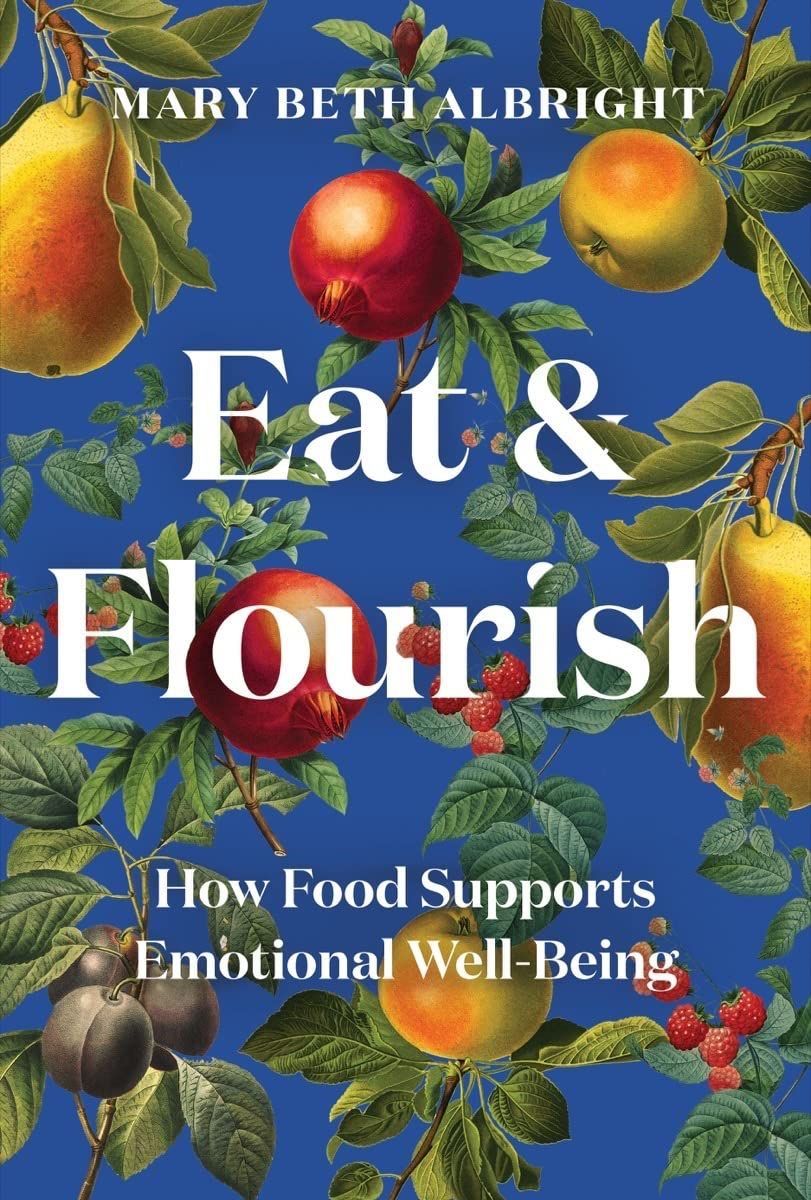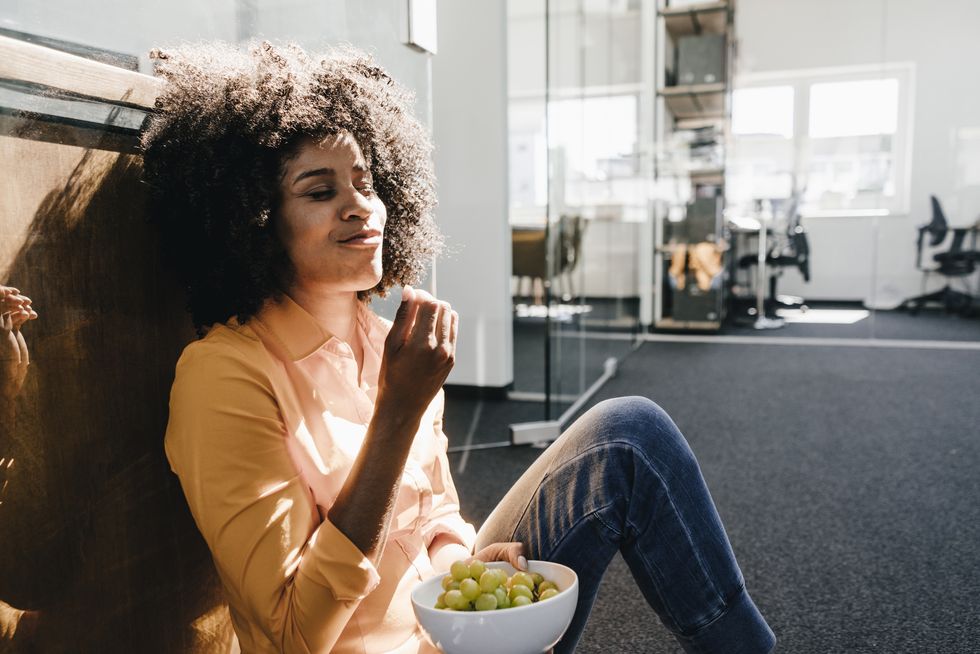Caring for our mental health is more essential than ever before. The way we treat our bodies, how and with whom we spend our time, and what thoughts take center stage in our minds are vital. In the monthly Shondaland series A Path to Well-Being, we’re sharing science and strategies to help you better understand and manage your well-being.
Anyone who’s felt hangry after too long without a snack or wanted to dive headfirst into a gallon of ice cream in the wake of heartbreak knows that food can affect mood. In recent years, scientists have confirmed the inextricable connection between food and feelings. It’s not just “hanger”— which is a real thing, BTW — or what we think of as “emotional eating” that affects our psychology, but everything we eat and how we eat it.
“The biggest misconception is that you can separate food from your mood, and food from emotional well-being, because you can’t,” says Mary Beth Albright, author of Eat & Flourish: How Food Supports Emotional Well-Being. “Truly, all eating is emotional eating. Because when we eat anything — a carrot stick, a piece of cake, a pizza — our bodies go through chemical changes that affect our emotions.”
The food we eat provides our bodies with the raw material it needs to make our cells, including brain cells. When it comes to food and mood, the connection is even deeper — gut-level deep, to be precise. The gastrointestinal tract is often called the “second brain” because it’s home to just as much neural activity as our brain and central nervous system, according to registered dietitian Lauren Cornell. These two brains are in constant communication.
Many of the neurotransmitters involved in regulating mood, including serotonin, dopamine, and GABA, are actually made in the gut by the trillions of microbes residing there. Collectively known as the gut microbiome, this ecosystem is responsible for how we process food and calories, along with how well we sleep and feel emotionally. What happens in our gut affects our brain chemistry and vice versa.
When it comes to eating for well-being, it’s not just about nutrients and definitely not about weight. It’s about balance, pleasure, and supporting the microbiome, giving our gut bugs what they need to help us thrive.
Each person’s microbiome is unique, “like a fingerprint,” Albright says, so there’s no universal recommendation for a prebiotic, probiotic, or superfood that guarantees an ideal gut environment. Beware of home microbiome tests that promise to show what you may be missing, Cornell adds, because most haven’t been scientifically validated and aren’t accurate enough to inform clinical practice.
Instead, look to a diverse diet that includes lots of whole foods. “Researchers say there’s nothing in our lifetime that we’re going to discover that’s more powerful than what we already have access to, and that’s the food system,” Albright says. “That system is perfect, and we’re just not using it.” Fortunately, each meal we eat alters the microbiome, so we have multiple opportunities to feed this system that supports our well-being.
Do a balancing act
To guide food choices, Albright uses the acronym PING, which stands for pleasure, inflammation, nutrients, and gut microbiome. Pleasure comes first because it’s a real reason why we eat, she says. Restrictive diets don’t breed happiness. “We don’t want to get rid of our emotional well-being,” she explains, “while we’re pursuing it.”
It’s important to balance eating for pleasure, avoiding inflammation, optimizing nutrition, and supporting the microbiome. Inflammation is a serious concern because inflammation anywhere in the body can affect emotional well-being, Albright says. Certain foods, particularly ultra-high-processed foods — those packaged goods with multiyear shelf lives — are known to cause inflammation, so minimizing those is a good place to start.
Eating with nutrients in mind supports overall wellness. Studies show the Mediterranean diet, with its emphasis on fruits, vegetables, whole grains, legumes, and olive oil, is among the healthiest eating patterns for both physical and mental well-being. This may be in part because fiber is critical for a healthy microbiome.
“Fiber comes from plant-based foods,” Cornell says. “One easy way people can make sure they’re taking good care of their gut microbiome is to make sure that they’re adequately hydrated and getting enough fiber.”
Dine on diversity
A study by the American Gut Project finds that people who eat 30 different plant foods a week have better health outcomes, including mental health outcomes, than those who eat 10 plants a week. If 30 plants a week sounds like a lot, don’t worry, Albright says. Most Americans already eat around 10 plants a week as part of their ordinary diet. Think: potatoes, corn, wheat, rice, soy, lettuce, tomato, onion, and the occasional apple or banana.
To boost plant diversity in your diet, buy a few fruits or vegetables a week you don’t usually, and go from there. Try some Swiss chard in your salad greens. Add berries to your oatmeal. Go nut with nuts, considering that Brazilian nuts, cashews, and almonds each represent a different plant.
Albright likes to hit up a supermarket salad bar and choose veggies she doesn’t often eat — a handful of radishes, some beets, some jicama — that she can munch on throughout the week. “That way, you’re getting some variety, and it’s not like you have to eat plants all day, all night, like a panda chewing on a bamboo stick,” she says. “It’s something that is really doable in addition to whatever you’re doing now.”
For an easy and delicious plant-based meal, Albright suggests roasting a variety of vegetables in olive oil. “We need to look to our vegetables,” she notes, “not just for the anti-inflammatory [and] gut microbiome effects, not just for the nutrients, but for the pleasure.”
Practice mindful eating
To understand what and when you’re eating and what truly makes you hungry, practice mindful eating, Cornell suggests. “Many of us speed through our meals or eat at our desk, on the run, or in our cars,” she says. “We’re just completely mindlessly eating.”
The antidote is to slow down and notice what’s happening. Cornell recommends having a designated place to eat and taking all meals and snacks there, so no more munching peanuts while pounding away at your computer. When you want a snack or it’s time for lunch, you head to the designated spot, whether that’s the dining room table or kitchen counter, then enjoy your food there. No scrolling, TV watching, or magazine flipping.
“This really helps you hone your hunger and satiety cues, which are really important,” Cornell says, adding that we sometimes go for a snack when what we really want is a distraction from whatever we’re doing or feeling. “It makes eating ceremonial again.”
It’s also worth being mindful of your attitudes around food, Cornell says. Judging foods as “bad” or linking food with exercise (“I have to be sure to work out tomorrow because I just ate donuts!”) can point to disordered eating, and that kind of judgment can take a toll on mood.
Bringing mindfulness to meal preparation can increase the pleasure we get from food, Albright says. Repetitive activities like chopping, peeling, or grinding “act on the vagus nerve in the same way that mindfulness does,” she says, “and the vagus nerve connects the gut directly to the brain.”
The act of simply assembling a meal — no chopping required — can heighten enjoyment. “When you’re engaging with the food on that level, that can affect the amount of pleasure you get from it,” Albright says. “It’s okay to buy a bag of already washed broccoli florets and throw them on a pan with some olive oil. Don’t let perfection be the enemy of the good with food.”
Sandy Cohen is a writer, health and wellness coach, and host of the Inner Peace to Go podcast. Follow her on Instagram @YouKnowSandy.
Get Shondaland directly in your inbox: SUBSCRIBE TODAY

















